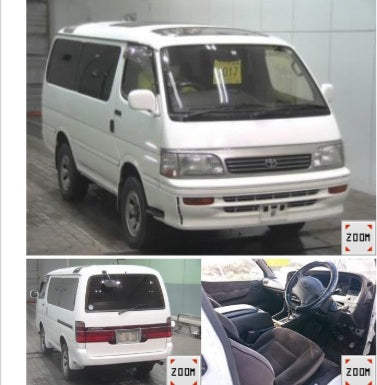Just imported from Japan Fed Legal 1995 Mitsubishi Pajero XR2 2.8L Turbo Diesel Intercooled SUV. This things a beast and really clean.
2.8L 4cylinder 4M4O Turbo Diesel Intercooled Engine with 86k miles Automatic 4wd with 4 Hi/Low/Center Locking Diff, LSD Rear Differential, Hard/Medium/Soft Suspension Settings, Power Folding Mirrors, Alot of Switches, Dual A/C/Heat Climate control for front and back, 4 Seater, Gray Cloth Seats, Sun Roof, Front Brush Guard with Fog Lights
Just installed new front rotors and brake pads, new batteries, rebuilt alternator, new glow pugs, new fuel filter, new oil pressure sensor(Old one was leaking around the top of it, common)
Only flaws are someone paint fade starting on top of silver fender flares and fog lights chrome has some imperfections. Truck has 0 rust
This truck runs and drives great, this thing is awesome and built to compete with all the land cruisers out there.
Please contact Rob 864-505-5621 for any questions, we also have many other vehicles in stock. I personally import these vehicles and have a yard in Japan. Dealing with us is direct and we cut out the middle men.
Mitsubishi redesigned the Pajeros for a second generation, which debuted in January 1991, although exports did not commence until later in the year. Just about everything was now new and further enhanced. A new, larger body was available in four different versions; Metal Top, Canvas Top Convertible (short wheelbase), Semi High Roof Wagon and High Roof Wagon (long wheelbase). The short wheelbase models were stretched by 70 millimetres (2.8 in) and the long-wheelbase models by 30 millimetres (1.2 in). The available engines included a 3.0-litre 12-valve SOHC (6G72) with ECI-Multi electronic fuel injection and a 2.5-litre turbocharged diesel engine (4D56T) with an intercooler.
1997 Mitsubishi Pajero (NL) GLS wagon (Australia)
The second generation also saw the introduction of Super Select 4WD (SS4) [known as ActivTrak 4WD in some markets], multimode ABS, which were firsts on Japanese four-wheel drives, and electronic shock absorber. SS4 was ground-breaking in the sense that it combined the advantages of part-time and full-time four-wheel drive with four available options: 2H (high-range rear-wheel drive), 4H (high-range full-time four-wheel drive), 4HLc (high-range four-wheel drive with locked centre differential) and 4LLc (low-range four-wheel drive with locked centre differential). Another advantage of this second generation system is that it gave the driver the ability to switch between two-wheel drive and full-time four-wheel drive at speeds up to 100 km/h (62 mph), whereas the first generation Pajero had to be stationary to switch from rear-wheel drive to four-wheel drive (but not from four-wheel drive back to rear-wheel drive). In addition to the SS4, an air locking differential was included as factory option. Either 4HLc or 4LLc mode must be engaged to perform this operation. Multimode ABS, on the other hand, was equally innovative. This meant ABS would be fully functional in all modes of SS4, as braking with a locked centre differential requires completely different braking parameters. The new electronic shock absorber was also factory option with three settings: S (soft), M (medium), and H (hard). This meant driver can change ride quality and handling depending on road conditions via a switch on centre console.
In July 1993, two new power plants were introduced; a 3.5-litre 24-valve DOHC with ECI-Multi and a 2.8-litre turbocharged diesel with an intercooler. A new, larger transmission and transfer case was also part of the upgrade.
1994 Mitsubishi Pajero (NJ) GLS wagon (Australia)
1993 Mitsubishi Pajero (NJ) GLS hardtop (Australia)
In 1996 the 3.0 V6 engine was revised, staying SOHC but changing to 24v. At the same time the ignition system was upgraded from the old distributor system to solid state coil packs. Power to 132 kW (177 hp). The 2.4 engine was introduced as a smaller power plant available only on SWB body with revised minor interior and exterior.
The Pajero Evolution was introduced in October 1997, which was developed in response to new entry requirements for the Paris – Dakar Rally's T3 Class. The Pajero Evolution came standard with a 3.5-litre 24-valve DOHC V6 with Mitsubishi Innovative Valve Timing and Electronic Lift Control (MIVEC). A new, dual plenum variable intake helped increase power and a new independent rear suspension made the ride even smoother.
In 1998, vehicles destined for General Export and the GCC (Gulf Cooperation Council countries) received a facelift. Wider fenders, new headlights, grille, bumper, fog lights and sidesteps were all part of the redesign. The wide fenders are often called "blister flare fenders". Driver and front-passenger SRS airbags were made standard on models equipped with the 3.5-litre DOHC V6 engine, whilst still remaining optional on GLS models with the 3.0-litre SOHC V6. 1080 of these units were also assembled in Iran by Bahman Khodro Group before being taken off production. An upgraded interior wood trim was made available on 3.0-litre GLS and 3.5-litre models. A leather-wrapped or leather and wood trim steering wheel was also made available, alongside an upgraded suspension and steering system. The 3.0-litre 12-valve SOHC engine was now available with a 24-valve configuration. Models without wide fenders remained as base models (GLX), available with a 2.4-litre 16-valve DOHC engine, producing 110 kW (147 hp). The 3.0-litre 12-valve engine was optional on these GLX models, and remained the base engine on the GLS.
The second generation was introduced on 22 January 1991 and manufactured until 1999. It retained the two body styles, but design was rounder and more city-friendly than the previous bulky model. The 3.0 L V6 petrol engine was retained, now available with a 24-valve head, capable of 136 kW (185 PS; 182 hp), while the 2.5 turbodiesel's power was slightly increased to 73 kW (99 PS; 98 hp). In 1993, the Pajero was slightly restyled, and larger engines were introduced, a 3.5 L V6 with 153 kW (208 PS; 205 hp) and a 2.8 L SOHC turbodiesel rated at 92 kW (125 PS; 123 hp). These versions introduced Mitsubishi's Super Select four-wheel-drive system (known as Active-Trac in the United States), with an electronic transfer shift that could split power between both axles without the need to stop the car. It worked at speeds up to 100 km/h (62 mph).
The first generation Pajero was also marketed as the Hyundai Galloper in Korea, Europe and GCC Countries, while the second generation was in production elsewhere.
This model Pajero remained in production in India till 2012 as the Pajero SFX; the latest generation is sold as the Montero. In the Philippines it is marketed as the Pajero "Field Master" 4x2 with the 2.8L TD engine, alongside the fourth generation Pajero. The 4X4 version was taken out of production in 1999. It is also produced in Colombia from Complete Knock Down parts (CKD) till 2012, with a 2.4l 16 valve SOHC (130 PS) or 3.0l 12 valve V6 (148 PS), both engines are available as a three-door hard top, the five-door wagon only with the 3.0-litre V6.
In Venezuela, the second generation was manufactured from 1992 to 1995 under the name of Mitsubishi Montero, it was available in long and short wheel base. From 1996 to 2009 its name was changed to Mitsubishi Montero Dakar, it was only available in short wheel base with 6G72 engine and manual five-speed transmission.
In China, the second generation Pajero remains popular as it was involved in early joint ventures from the 1990s. Companies include Guangtong Motors, Jincheng Motors, Jinhui Motors, Sanjiu Motors, Sanxing Motors, Shanlu Motors and Wanli Motors.
Chinese car manufacturer Shanlu Motors made their version of the Pajero known as the CJY 6421D and was produced from 1997 to 2001 and came standard with the 4G64 engine.[20] Beijing Automobile Works followed suit and produced their version known as the BJ2032 Tornado from 2002 to 2004. The BJ2032 came standard with a 2.2-litre engine sourced from General Motors paired to a 5 speed manual gearbox. The Tornado is 4880 millimetres long, 1830 millimetres wide, 1800 millimetres high and utilizes a 2750 millimetre wheelbase.
The most well known variants of the Pajero sold in China were built by GAC Changfeng since 1995. The first known model was produced from 2002 to 2014 and marketed under the name Liebao Heijinggang (猎豹奇兵-黑金刚 Leopaard Black King Kong, whereas 猎豹 can be translated to 'cheetah' instead of 'leopard') for the 2002 model year. The Heijinggang was available with four engines, the 2.2-litre 4RB3 based on the 2RZ-FE engine from Toyota, the popular 2.4-litre 4G64 engine and 6G72 V6 from both Mitsubishi and a 2.5-litre turbo diesel. All engines were paired to a 5 speed manual gearbox. The 4 speed automatic was only available on the 2002 Heijinggang with the V6 engine. Throughout its production run, pricing ranged between 109,800 and 302,800 (15,930 and US$43,930).
GAC Changfeng-Leopaard Pajero (China)
The sister model, known as the Qibing/6481, was produced from 2009 until 2014. The 2.2-litre 4RB3 was the only engine available paired to a 5-speed manual gearbox. Two models were available priced at 99,800 and 124,800 yuan (14,480 and US$18,100).
Both models were replaced by a face-lifted version called the Leopard Q6 (猎豹Q6) that year and is still in production today.[21][22][23][24] The Q6 used the 4G63 for 2015 and 2017 models paired to a 6 speed manual and automatic gearbox. The 2TZ-FE engine from Toyota was also available alongside it paired to a 5 speed manual gearbox. For 2019 onwards, the Q6 currently uses the 4G64 like its predecessors and uses a 5 speed manual gearbox. Two colours choices known as: Wild Green and Glacier White are available as standard. Pricing ranges between 119,900 yuan and 169,800 yuan (17,395 and US$24,630).[25]
The second generation Pajero was discontinued in 1999 (with the exceptions mentioned under Production), and replaced by a new-generation Pajero. After ending production, the second generation Pajero gained unwanted attention in 2002 when TLC member Left Eye was killed in a car crash involving a second generation Mitsubishi Pajero, on a highway in La Ceiba, Honduras. She was the only fatality in the crash. A camera man was filming from the front passenger's seat, and his camera was destroyed on impact.






























































